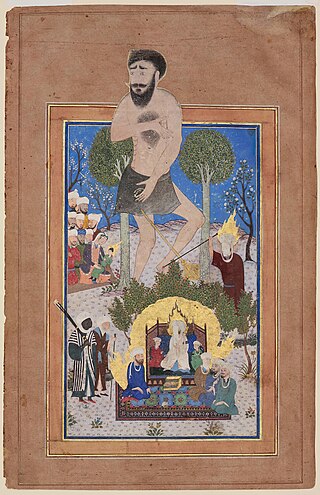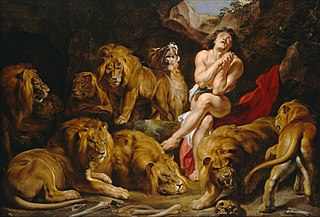
Danel ( /ˈdeɪnəl/ , Ugaritic: 𐎄𐎐𐎛𐎍 DNỈL, "El is judge"), [1] father of Aqhat, was a culture hero who appears in an incomplete Ugaritic text of the fourteenth century BCE [2] at Ugarit (now Ras Shamra), Syria.

Danel ( /ˈdeɪnəl/ , Ugaritic: 𐎄𐎐𐎛𐎍 DNỈL, "El is judge"), [1] father of Aqhat, was a culture hero who appears in an incomplete Ugaritic text of the fourteenth century BCE [2] at Ugarit (now Ras Shamra), Syria.
The text in Corpus Tablettes Alphabétiques[CTA] 17–19 is often referred to as the Tale of Aqhat . Danel was depicted as "judging the cause of the widow, adjudicating the case of the fatherless" in the city gate. [3] He passed through trials: his son Aqhat was destroyed but apparently in the missing conclusion was revived or replaced by Danel's patron god, Rpʼu, who sits and judges with Hadad and Astarte and was likely considered to be the equivalent of El.
The text was published and translated in 1936 by Charles Virolleaud [4] and has been extensively analysed since then. [5]
The text of The Rephaim , a title given to the text by Mark S. Smith, also mentions Danel, who appears there and in the Tale of Aqhat as "a model figure in family matters of life and death". [6] In these texts Danel in mentioned as one who invites the Rephaim, divine beings of the underworld, to a feast during the late summer fuit harvest, reminiscent of the biblical festival of booths. [7] Danel's title in the text of Rephaim is "the man of Rapau", while Rapau is identified in another Ugaritic text as a god and king of Ashtaroth and Edrei, both cities related to Og the king of Bashan in the biblical account. [8]
Three verses in the Book of Ezekiel (Ezekiel 14:14 and 20 and 28:3) refer to דנאלdnʾl which, according to the Masoretic Text, should be read as "Daniel". This notwithstanding, parallels and contrasts with Danel (without an i) [9] of Ezekiel, placed between Noah and Job [10] and invoked as the very example of righteous judgement, [11] first pointed out by René Dussaud in 1931, [12] have led readers commonly to accept [13] or occasionally to reject [14] [15] a degree of identification with Ugaritic Danel of the Tale of Aqhat, amounting virtually to the same figure. [16] [17]
The three figures referred to in Ezekiel 14:14 — "Even if Noah, Danel and Job were in it" — links the name with two non-Israelites of great antiquity. In Ezekiel 28:3, Danel is one noted for his wisdom in the prophecy addressed to the king of Tyre: "you are indeed wiser than Danel, no secret is hidden from you". The name "Danel" had a long tradition in Hebrew culture: he is supplied as the father-in-law of Enoch in the Book of Jubilees . [18]
Texts in Ugaritic, a language closely related to the Canaanite languages, may provide an important clue. The language was discovered by French archaeologists in 1928 and known only from texts found in the lost city of Ugarit, Syria. [19] Ugaritic has been used by scholars of the Hebrew Bible to clarify Biblical Hebrew texts and has revealed ways in which ancient Israelite culture finds parallels in the neighboring cultures. [19] Ugaritic was "the greatest literary discovery from antiquity since the deciphering of the Egyptian hieroglyphs and Mesopotamian cuneiform." [20]
Literary texts discovered at Ugarit include the "Tale of Aqhat" (or Legend of Danel), revealing a Canaanite religion. According to Edward L. Greenstein, a distinguished professor at Bar-Ilan University, Ugaritic texts solved the biblical puzzle of the anachronism of Ezekiel mentioning Daniel at Ezekiel 14:13–16; it is because in both Ugaritic and the Ancient Hebrew texts, it is correctly Danel—the yod is missing in the originals. [19]
Danel would fit the pattern of being an ancient non-Israelite like Job and Noah. Ezekiel's literary arrangement may also support this position. Yahweh has compared Judah with foreign nations before (Ezekiel 5:7), and the context appears to contain a similar comparison in Ezekiel 14:13–19. The hypothetical rebellious country, while a cipher for Israel, is not explicitly named and could represent any ancient Near Eastern country. Ezekiel's audience is enamored with non-Israelite myths (cf. Tammuz in Ezekiel 8:14), and so they could easily be aware of King Danel's legendary virtues. Thus, if they were three ancient, righteous, non-Israelite men, Ezekiel's triad would fit the pattern of Yahweh judging Israel to some degree by the nations around them. [21] The connection is more plausible when one considers that Ezekiel alludes to Danel in an oracle against Tyre (Ezekiel 28). [22] Danel also had a son and, like Job, was unable to deliver him from divine harm (cf. Ezekiel 14:20). [23]
The name Danel has been given to one of the craters on Ganymede, a moon of Jupiter.

Canaan was a Semitic-speaking civilization and region of the Southern Levant in the Ancient Near East during the late 2nd millennium BC. Canaan had significant geopolitical importance in the Late Bronze Age Amarna Period as the area where the spheres of interest of the Egyptian, Hittite, Mitanni, and Assyrian Empires converged or overlapped. Much of present-day knowledge about Canaan stems from archaeological excavation in this area at sites such as Tel Hazor, Tel Megiddo, En Esur, and Gezer.

The Israelites were a Hebrew-speaking ethnoreligious group consisting of tribes that inhabited much of Canaan during the Iron Age.

El is a Northwest Semitic word meaning 'god' or 'deity', or referring to any one of multiple major ancient Near Eastern deities. A rarer form, 'ila, represents the predicate form in the Old Akkadian and Amorite languages. The word is derived from the Proto-Semitic *ʔil-.
Ugarit was an ancient port city in northern Syria about 10 kilometers north of modern Latakia. At its height it ruled an area roughly equivalent to the modern Latakia Governorate. It was discovered by accident in 1928 with the Ugaritic texts. Its ruins are often called Ras Shamra after the headland where they lie.

Ugaritic is an extinct Northwest Semitic language known through the Ugaritic texts discovered by French archaeologists in 1928 at Ugarit, including several major literary texts, notably the Baal cycle.

Asherah was a goddess in ancient Semitic religions. She also appears in Hittite writings as Ašerdu(s) or Ašertu(s), and as Athirat in Ugarit. The majority of scholars hold that Yahweh and Asherah were a consort pair in ancient Palestine and Judah, while others disagree.
The Hivites were one group of descendants of Canaan, son of Ham, according to the Table of Nations in Genesis 10 (10:17). A variety of proposals have been made, but beyond the references in the Bible to Hivites in the land of Canaan, no consensus has been reached about their precise historical identity.
Ancient Semitic religion encompasses the polytheistic religions of the Semitic peoples from the ancient Near East and Northeast Africa. Since the term Semitic represents a rough category when referring to cultures, as opposed to languages, the definitive bounds of the term "ancient Semitic religion" are only approximate but exclude the religions of "non-Semitic" speakers of the region such as Egyptians, Elamites, Hittites, Hurrians, Mitanni, Urartians, Luwians, Minoans, Greeks, Phrygians, Lydians, Persians, Medes, Philistines and Parthians.

Canaanite religion was a group of ancient Semitic religions practiced by the Canaanites living in the ancient Levant from at least the early Bronze Age to the first centuries CE. Canaanite religion was polytheistic and in some cases monolatristic. It was influenced by neighboring cultures, particularly ancient Egyptian and Mesopotamian religious practices. The pantheon was headed by the god El and his consort Asherah, with other significant deities including Baal, Anat, Astarte, and Mot.

Shalim is a pagan god in Canaanite religion, mentioned in inscriptions found in Ugarit. William F. Albright identified Shalim as the god of the dusk and Shahar as the god of the dawn. In the Dictionary of Deities and Demons in the Bible, Venus is represented by Shalim as the Evening Star and Shahar as the Morning Star. His name derives from the triconsonantal Semitic root Š-L-M.

In the Hebrew Bible, as well as non-Jewish ancient texts from the region, the Northwest Semitic term Rephaite or Repha'im refers either to a people of greater-than-average height and stature in Deuteronomy 2:10-11, or departed spirits in the afterlife, Sheol as written in the following scriptures: Isaiah 26:14; Psalms 88:10, and Proverbs 9:18, as well as Isaiah 14:9.
Mark Stratton John Matthew Smith is an American Old Testament scholar and professor.
The Schweich Lectures on Biblical Archaeology are a series of lectures delivered and published under the auspices of the British Academy. The Leopold Schweich Trust Fund, set up in 1907, was a gift from Miss Constance Schweich in memory of her father. It provided for three public lectures to be delivered annually on subjects related to ‘the archaeology, art, history, languages and literature of Ancient Civilization with reference to Biblical Study’. The three papers given by each lecturer are published together in book form, by Oxford University Press. There have been many reprintings.

Daniel is the main character of the Book of Daniel. According to the Hebrew Bible, Daniel was a noble Jewish youth of Jerusalem taken into captivity by Nebuchadnezzar II of Babylon, serving the king and his successors with loyalty and ability until the time of the Persian conqueror Cyrus, all the while remaining true to the God of Israel. While some conservative scholars hold that Daniel existed and his book was written in the 6th century BCE, most scholars agree that Daniel is not a historical figure and that much of the book is a cryptic allusion to the reign of the 2nd century BCE Hellenistic king Antiochus IV Epiphanes.
Shapshu or Shapsh, and also Shamshu, was a Canaanite sun goddess. She also served as the royal messenger of the high god El, her probable father. Her most common epithets in the Ugaritic corpus are nrt ỉlm špš, rbt špš, and špš ʿlm. In the pantheon lists KTU 1.118 and 1.148, Shapshu is equated with the Akkadian dšamaš.

The Legend of Keret, also known as the Epic of Kirta, is an ancient Ugaritic epic poem, dated to Late Bronze Age, circa 1500 – 1200 BCE. It recounts the myth of King Kirta of Hubur. It is one of the Ugaritic texts.

The Tale of Aqhat or Epic of Aqhat is a Canaanite myth from Ugarit, an ancient city in what is now Syria. It is one of the three longest texts to have been found at Ugarit, the other two being the Legend of Keret and the Baal Cycle. It dates to approximately 1350 BCE.

The Ugaritic texts are a corpus of ancient cuneiform texts discovered in 1928 in Ugarit and Ras Ibn Hani in Syria, and written in Ugaritic, an otherwise unknown Northwest Semitic language. Approximately 1,500 texts and fragments have been found to date. The texts were written in the 13th and 12th centuries BC.

Puġat or Pughat is a character in the Ugaritic poem of the Tale of Aqhat from Canaanite myth. Her name is the common noun for 'girl'. She is described as follows: "She who carries water / she who collects dew on her hair / she who knows the course of the stars."
Marzēaḥ was an ancient Northwest Semitic religious and social ceremony and institution. The marzēaḥ was related to wine-drinking, and at least sometimes had a presiding leader or master of ceremonies. Some evidence relates the marzēaḥ to mourning and veneration of the dead, and the nature of this relationship is discussed by scholars; the institution of the marzēaḥ was not necessarily static, and may have changed throughout the many centuries and locations of its existence. Many of the attestations of the marzēaḥ do not provide sufficient context for conclusion about the nature of the ceremony.